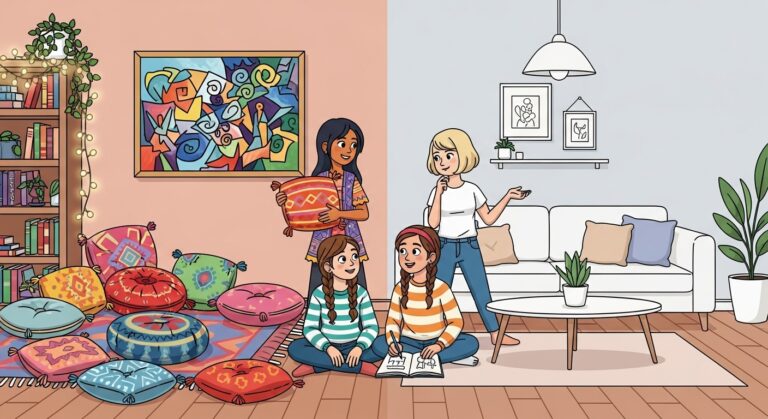In a bustling city where the noise of life never seemed to quiet down, an eighteen-year-old named Mia found herself at a crossroads. Having moved into a rent-by-bedroom apartment in late June, she was eager to embrace her independence. The thrill of living on her own, however, was overshadowed by a rather mundane issue—decorations.
Mia had shared the apartment with her previous roommates for over a year, but when they departed, they took with them every last piece of decoration, leaving behind a stark room that felt more like a concrete box than the vibrant home she had hoped for. Her friends often teased her about her minimalist lifestyle, joking that her rooms resembled a jail cell. Yet, Mia didn’t mind. Her focus lay elsewhere—on her studies, her part-time job, and her burgeoning social life. She hardly spent time in her room, so why would she invest in decor?
As summer faded into autumn, Mia’s new roommates, Sarah, a 33-year-old artist, and Jenna, a 23-year-old graduate student, began to take notice of the emptiness around them. They were both eager to transform the common areas into a welcoming space filled with warmth and creativity. One evening, while lounging on the lone, worn-out couch, Sarah turned to Mia with a hopeful expression.
“Mia, we were thinking it would be great to spruce up the apartment together. What do you say?” she asked, her eyes sparkling with excitement.
Jenna chimed in, “Yeah! We could go shopping and pick out some fun decorations! It’ll make the place feel more like home.”
Mia sat there, a slight frown knitting her brows together. “I appreciate the thought, but I really don’t care about decorations,” she replied honestly. “I hardly spend time in the common area, anyway. I just use it to eat and pass through.”
“But you do use the space,” Sarah protested gently. “It would be nice for all of us to enjoy it together. Plus, it won’t be that expensive if we split it three ways!”
“Yeah, and it could be a fun bonding experience!” Jenna added, her enthusiasm palpable.
Mia could see the genuine excitement in their eyes, but she remained steadfast in her perspective. “I really don’t want to spend money on decorations. I’d rather keep things simple.”
The conversation shifted into a back-and-forth debate, with Sarah and Jenna trying to persuade Mia to reconsider. They suggested themes, colors, and even DIY projects. Yet, every time they tossed out an idea, Mia countered it with her indifference. She felt like an outsider in her own living space, not out of spite, but because she simply didn’t share their vision.
As the days went by, the tension in the apartment grew. Sarah and Jenna began to feel frustrated, while Mia felt misunderstood. The common area remained bare, and Mia’s determination to stick to her minimalist ways only intensified their desire to spruce things up.
One weekend, as Mia returned home from a long shift at her part-time job, she was greeted by an unexpected sight. The common area had transformed into a colorful haven, with fairy lights strung across the ceiling, vibrant cushions scattered around, and a big, cheerful painting hanging on the wall—a collaborative effort by Sarah and Jenna. Mia stood at the doorway, her mouth slightly agape, caught between admiration and annoyance.
“What happened here?” she asked, trying to mask her surprise with a hint of irritation.
“We decorated!” Jenna exclaimed, her eyes alight with pride. “We took your lack of interest as a sign to go ahead and make it our own.”
Mia felt a wave of conflicting emotions crash over her. On one hand, she appreciated the effort and the beautiful transformation; on the other hand, she felt they had disregarded her feelings and opinions. “You didn’t talk to me about this,” she said, trying to keep her voice steady.
“We thought you wouldn’t mind since you didn’t want to contribute,” Sarah explained, her expression shifting from joy to concern. “We just wanted to create a space we all could enjoy.”
Mia took a moment to process their perspective. “I get that, but I also feel like this is a shared space, and I’m not on board with the whole decorating idea. I like it simple. It feels… comfortable for me.”
The room fell silent as the weight of the moment settled in. After a few awkward seconds, Jenna spoke up. “Maybe we can find a compromise? We could keep some of the decorations but also leave parts of it simple, in a way that feels right for all of us.”
Mia considered this. “That could work,” she replied thoughtfully. “If you really enjoy the decorations, I don’t want to take that joy away from you. But I’d like to maintain some areas as they are.”
Sarah nodded enthusiastically. “How about we designate a ‘decorated’ corner and a ‘minimalist’ corner? That way, everyone gets a space that makes them happy!”
With a newfound understanding, the trio spent the rest of the evening discussing their preferences and ideas. They laughed, shared stories, and even engaged in a bit of playful banter about their different tastes. By the end of the night, they had created a plan that honored both Mia’s desire for simplicity and Sarah and Jenna’s passion for creativity.
In the weeks that followed, the apartment thrived with a balance of decoration and minimalism. Mia discovered that the vibrant colors and eclectic decor brought a certain warmth to her home, and she even found herself enjoying the lively atmosphere. The common area became a hub of laughter and camaraderie—an inviting space where all three roommates could come together, share meals, study, and create lasting memories.
Mia learned that sometimes, compromise leads to unexpected joy. The concrete box she once resided in had transformed into a vibrant home, filled with laughter, creativity, and friendship. And while she may not have been the one to pick out the decorations, she found happiness in the shared moments that filled the space with life.
—





0 Comments